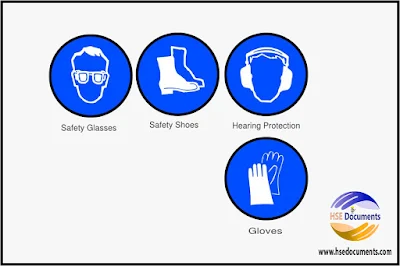Personal protective equipment (PPE)
The Personal protective equipment (PPE) is equipment, device, and tool or in the shape of clothing (overall, uniform, high visibility jackets, apron or leather shields, etc.) devised to be used or worn by personals, employees, technical staff to protect themselves or other from the critical and hazardous risk of injury or illness. Personal protective equipment (PPE) can include the following:⦁ The hearing protective devices and or equipment, e.g., earmuffs or earplugs
⦁ The respiratory protective equipment devices
⦁ The face and eye protection, for example, safety goggles and face shields or face visors
⦁ The head protection safety helmets or hard hats
⦁ The full-body fall arrest harnesses system for working at heights
⦁ The skin protection e.g. gloves and sunscreen
⦁ The variety of clothing, such as high visibility vests, life jackets and coveralls
⦁ The Foot protection, such as safety shoes and rubber footwear
The Last Resort-Personal Protective Equipment (PPE)
The Personal protective equipment (PPE) is worn in the worksite to protect and safeguard the worker’s eyes, foot, head, skin, hands and other parts of the body on the worksite.According to the hierarchy of hazard control, despite the Personal protective equipment (PPE) is one of the most trivial forms of hazard control and detected on the most of the work projects, that is why it is called “The Last Resort-Personal Protective Equipment (PPE)”.
Personal protective equipment (PPE) is not considered highly effective because it does not control worksite hazards. Rather, the Personal protective equipment (PPE) objective to protect employees and or workforce in case of a hazard occurs.
The use of Personal protective equipment (PPE) is least on the list of control priorities and measures. Such type of controls must not be looked on as the basic means of risk control until the preference higher in the list of control priorities and measures have been disabled.
Hence, the Personal protective equipment (PPE should only be worn:
⦁ The PPE as a last resort, where there are no other practical control measures and or options available
⦁ The PPE is a short-term measure, not a permanent solution, as far as a more sufficient way of controlling or minimizing the risk can be utilized
There may be particular and or clear-cut Personal protective equipment (PPE) condition for working with harmful or hazardous substances or chemicals in assertive work tasks.
The Question-Who pays for the PPE?
The employer or the personal who deals with the business or the owner of the organization must provide the Personal Protective Equipment (PPE) to his employees and or workers free of charge.Anyhow, there may be a variety of times where the premium for Personal protective equipment (PPE) it can be accommodated.
Who should provide PPE acknowledgement?
⦁ The possibility of equipment and or apparatus
⦁ whether the equipment or equipage can commonly be utilized beyond work, such as safety goggles, sunglasses or safety shoes
⦁ The personal fit PPE requirements
The Selection of Personal protective equipment (PPE)
While selecting the PPE, always to look at these following aspects:
The Workforce
⦁ Review if the PPE is the correct size and fits for each employee. Overall or safety shoe equipment, e.g., requires a fit size and quality as per the required OSHA standards.⦁ If Personal protective equipment (PPE) is convenient to wear and employees are consulted or asked while selecting it, because works have to use it, so they are more familiar with its quality, size and convenience to use it.
⦁ While selecting, buying or choosing the PPE’s, the individual circumstances of workers must keep in knowledge. For example, wearing prescription goggles, allergies such as latex allergy and some medical circumstances.
The Job Activity or Work Task
⦁ Always while selecting the PPE, in the contest with the PPE to the hazard, keeping in mind that a work task may expose workers to more than one hazard. E.g., the welders’ workers may require protection from hazardous welding gases and fumes, as well as ultraviolet radiation, hot metal and sparks.⦁ The second point to take into consideration how the task is carried out and the level of risk to the employee. E.g., a more protective respirator may require to work where the level of air contamination is very high.
⦁ The duration of PPE to be worn.
The Work Environment
While selecting, buying and using the Personal protective equipment (PPE), always consider the impacts of a hot or humid work activity environment.If you are protecting your employees against exposure to a dangerous substance or chemical or a biological substance, look at how the chemicals can enter the body. E.g., where substances can be involved through the lungs and skin protection, as well as respiratory protection, may be required.
Always Choose PPE that meets your current business operating state or OSHA Standards.
The Maintenance of the Personal protective equipment (PPE)
Always take the following initiatives:⦁ Look for damaged parts before using PPE and repair or replace the PPE if it was as necessary.
⦁ Immediately replace PPE that has expired or overage.
⦁ Before use and after using the PPE, properly clean and maintain.
⦁ Immediately report to your project Health and safety responsible person to report the broken, damaged or contaminated Personal protective equipment (PPE).
The PPE-Information, training and instruction Initiatives
Always, the employees must be equipped with the appropriate information, training and instruction on when to use required and recommended PPE and how to utilize, fit and wear it including any adjustments that may be needed, the repair or replace parts and the clean and store it correctly.Download File









No comments:
Post a Comment